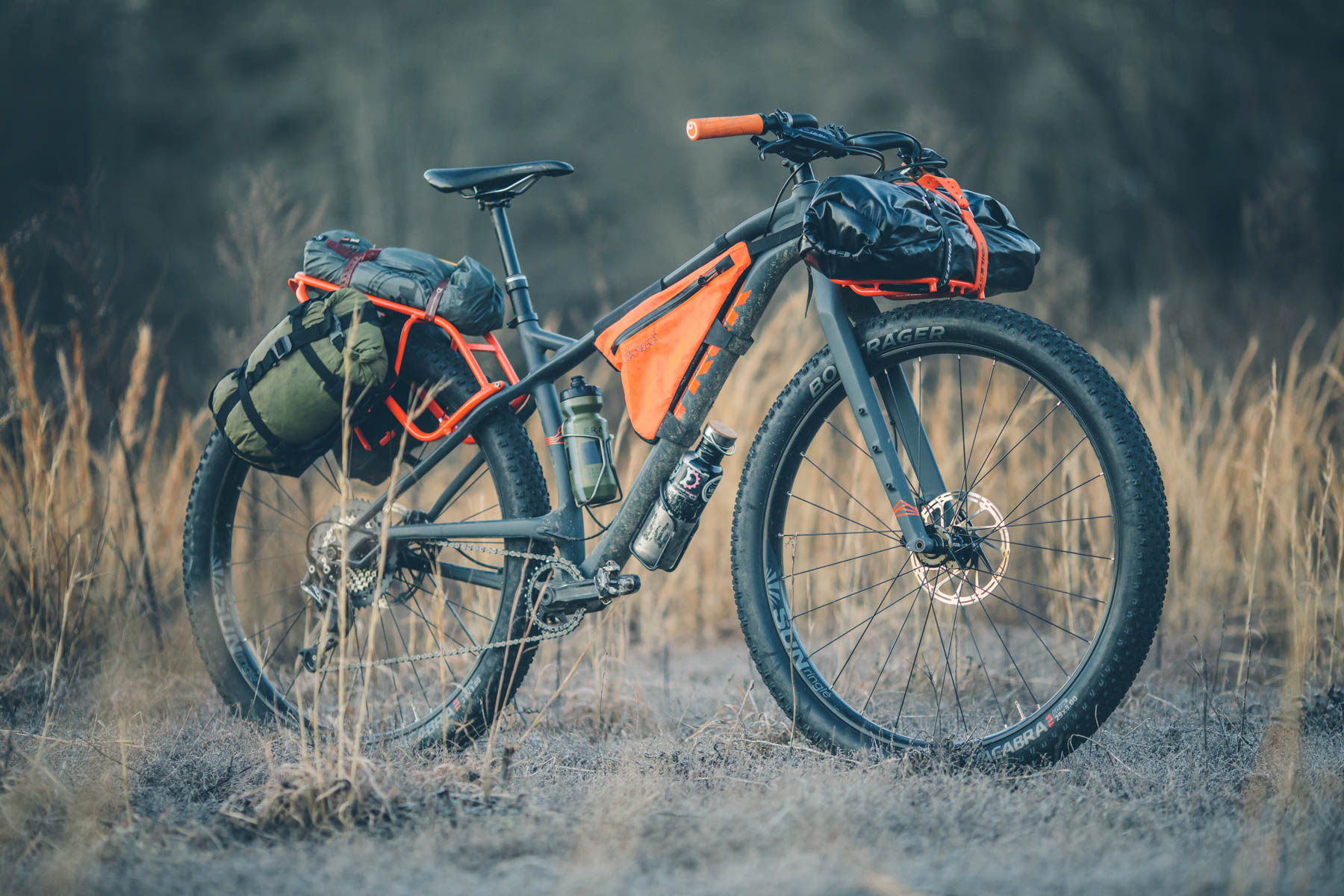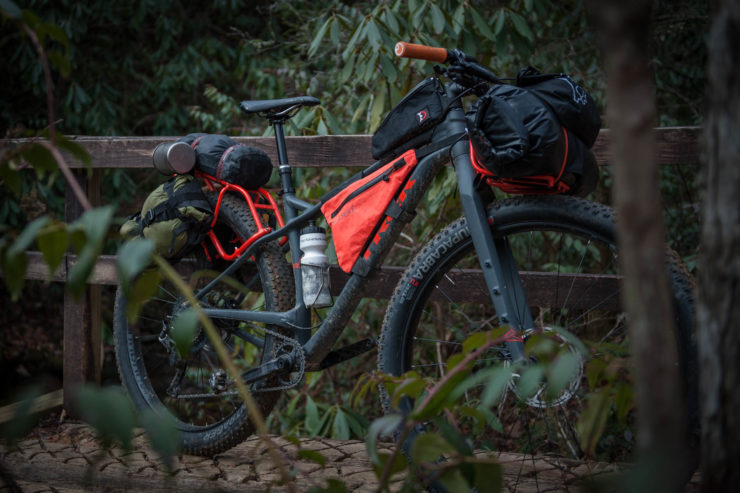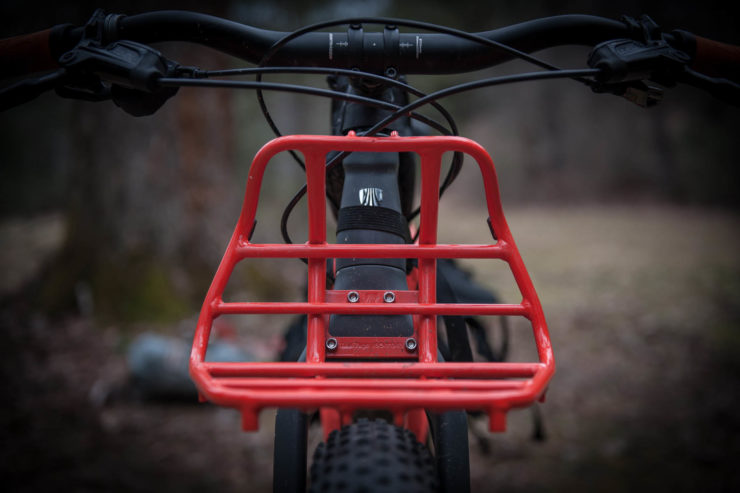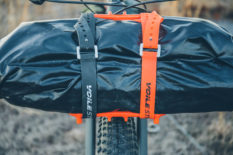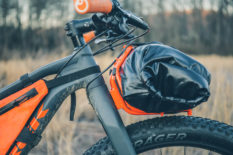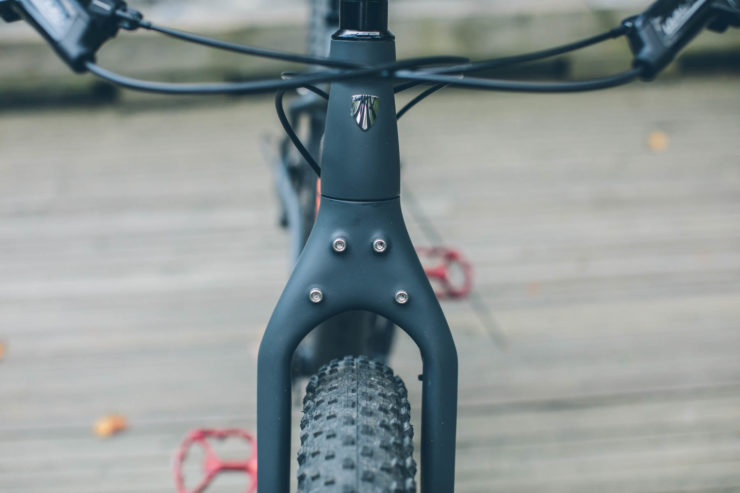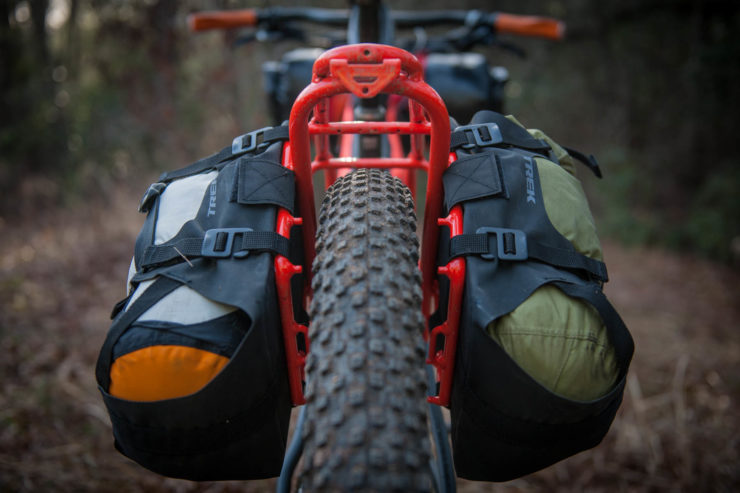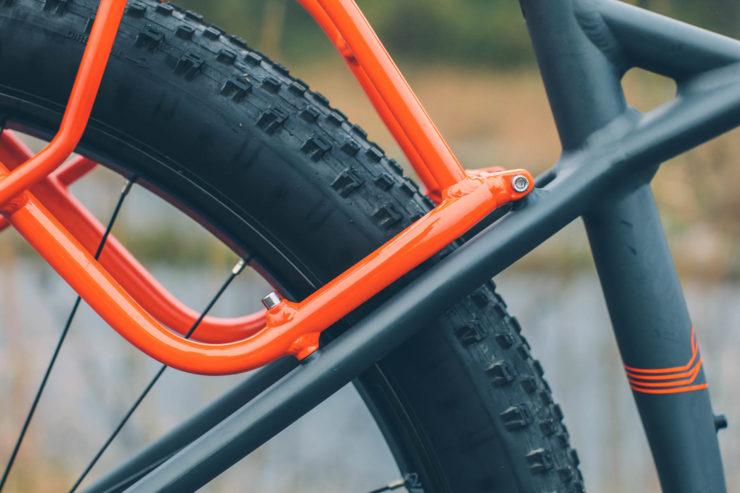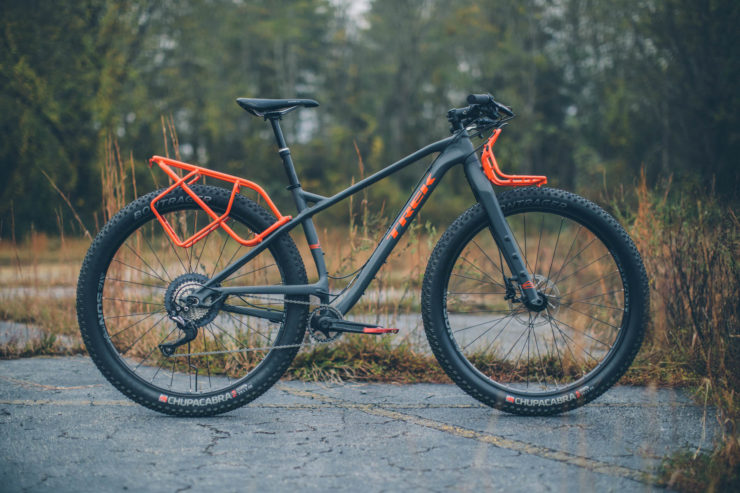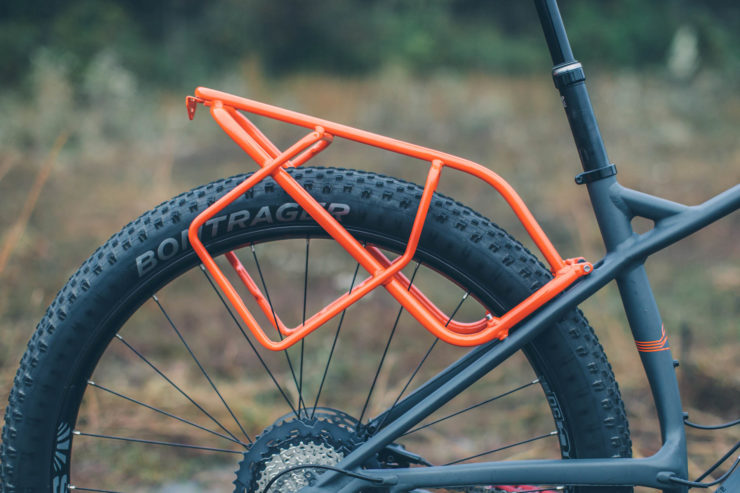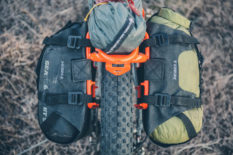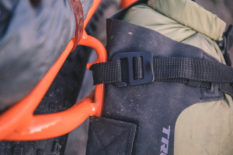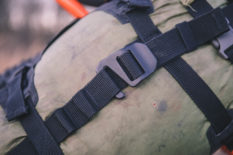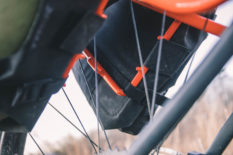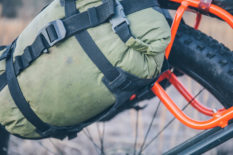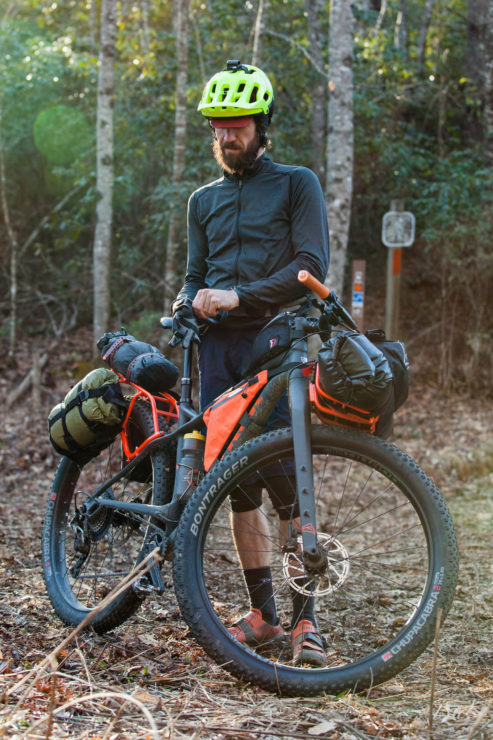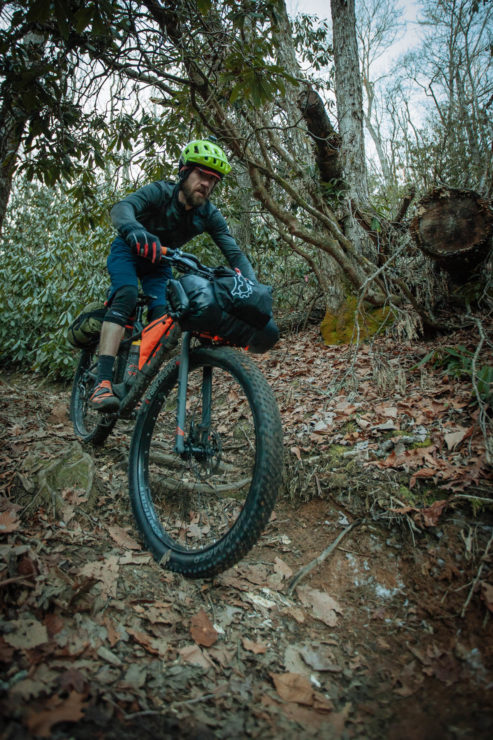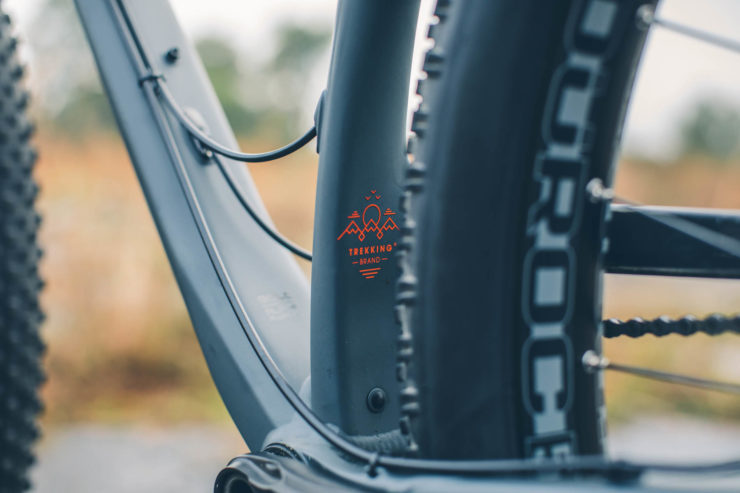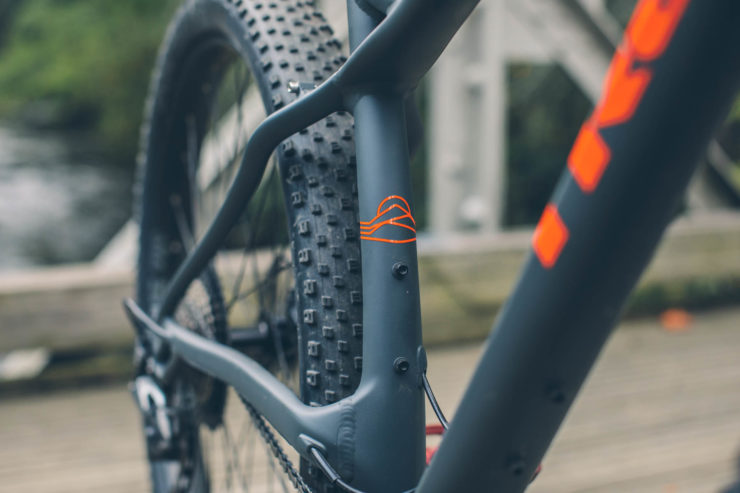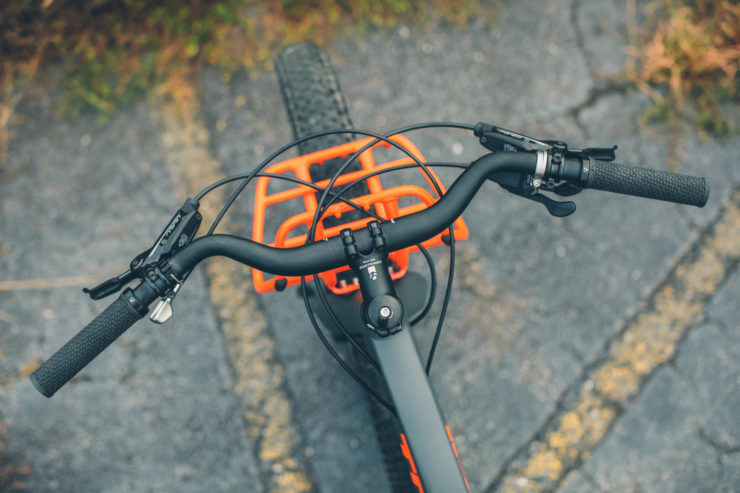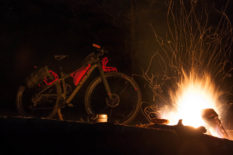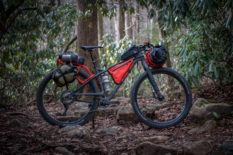Trek 1120 Review: Footsteps of Giants
Share This
The Trek 1120 follows in the same 29+ tracks that many bikepacking-specific rigs forged ahead of it, but this bike cuts its own trail with an innovative front rack, a thoughtfully designed rear harness system, and surprising trail prowess… all at a lighter weight than we expected. We’ve been quietly testing one over the last few months; here’s the full review.
With additional photos and insight by Ryan Sigsbey
With multiple companies creating bikepacking-specific bikes around the 29+ platform, it’s as if bikepacking has an official tire size. Bear in mind, big wagon wheels aren’t for everyone, and there are plenty of 27.5+ bikepacking rigs too, but it’s no surprise that this legacy continues to thrive… for plenty of reasons we’ve already covered within this site. It all started with the Krampus in 2012, and then came the Surly ECR, which was sort of the first big-tired purpose built bikepacking bike. It was only a matter of time before others created variations on the theme: The Chumba Ursa 29+, the Carver Gnarvester, Salsa’s Deadwood and Woodsmoke, the Bombtrack Beyond ADV, and the Why Wayward. There are a few others as well, and probably more to come.
- Highlights
- Frame/Fork: Aluminum/Carbon
- Seatpost: 31.6mm
- Bottom Bracket: PressFit 92
- Hub specs: 148 x 12mm (R); 110x15mm (F)
- Max tire: 29×3″
- Weight (L w/racks): 29.4 lbs (13.3 kg)
- Price: $2,499
Following suit, the 1120 was a natural progression for Trek. The Wisconsin based titan has a longstanding history of making bikes in the adventure travel and touring category. First the 520 and 720 touring bikes became classics back in the early 80s. Then Trek found success with its more recent gravel and dirt-drop tourer, the Trek 920. It only made sense to add a couple hundred to the naming schema for a big-tired bikepacking rig. And this they did with a bang, creating a 29+ rig that is quite a departure from all the rest, even their own Stache.
Before we dig in, let me clarify the nature of this review. I’ve had this bike since August, but an injury/surgery/recovery kept me off of it for a couple of months. Then I got about a dozen rides in with it and had a bit of a relapse… from which I am still recovering. So, I enlisted the help of Ryan Sigsbey, a friend, photographer, bikepacker, and creator of the Trans-WNC. Ryan took it for a week or so, gave it a few rides and took it on a bikepacking trip to add his perspective. As such, this isn’t a long term review. Instead you’ll find an in depth analysis and a couple different perspectives regarding our experiences using it, comparisons, technical details… and, as usual, plenty of photos (don’t miss the new carousel galleries).
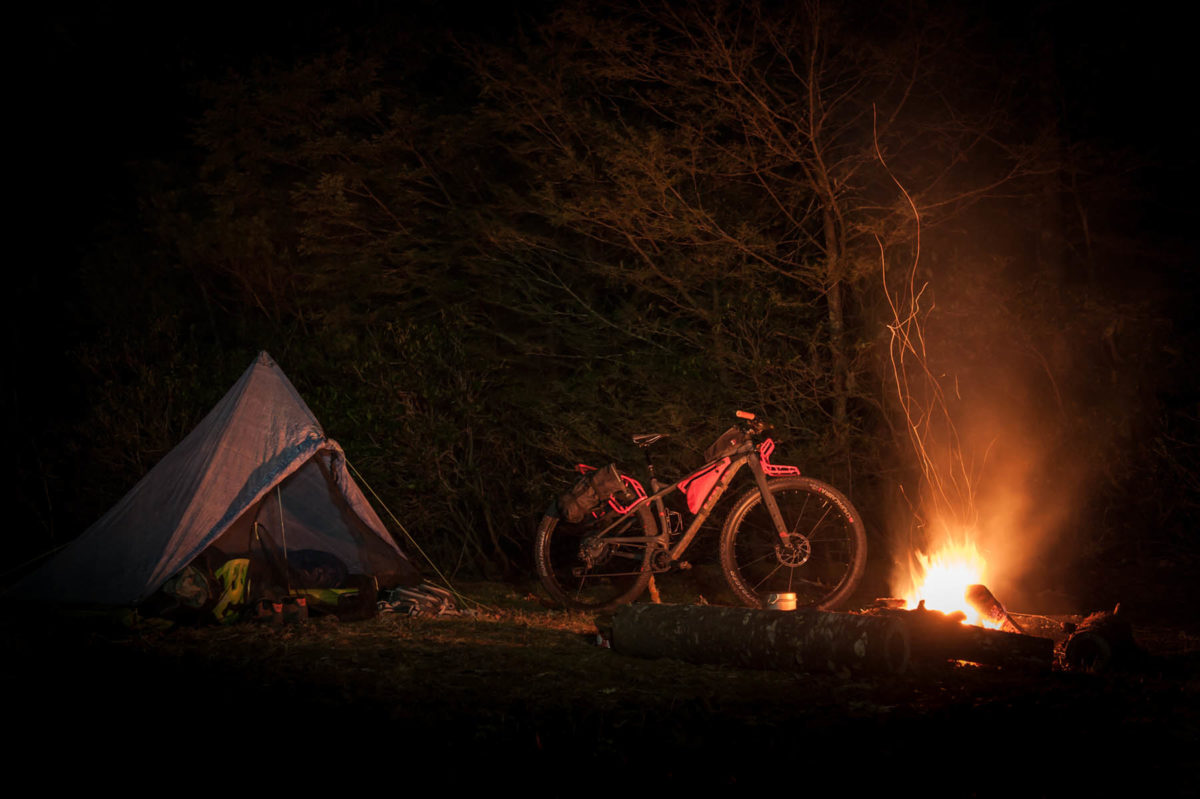
Newfangled Racks
There’s a lot to talk about with this bike, so let’s start with the 1120’s two most prominent features, the bright orange tangles of metal at its fore and aft. These proprietary aluminum racks provide a very stable platform for strapping all sorts of gear. They also eliminate the need for a standard seat pack and handlebar roll by offering innovative means of attaching equipment and drybags to the bike. In general, they allow the bike to carry more stuff than with a standard bikepacking setup.
The Front ‘Cradle’ Rack
Load capacity 7.03kg/15.5 lbs | Weight 441g
The Trek 1120’s unique fork-mounted front rack is designed to cradle a large dry bag or an assortment of other cylindrical objects — think tents, fishing rod tubes, sleeping mats, etc. This places the load just a scoach lower than a conventional handlebar roll, which, in theory, lowers the center of gravity and increases stability. The rack is incredibly user-friendly, very stable, and does a great job preventing bag and cable interference, which is its biggest innovation. It also eliminates the need for handlebar straps, which frees up valuable real estate on the bars. All the same, the chunky aluminum rack adds about 441 grams that wouldn’t be there with a handlebar mounted bag.
The Trek 1120 front rack is heftier and sturdier feeling than I expected. Constructed from heavy duty aluminum tubing welded to a thick mounting plate, the rack attaches to the Carbon Adventure Fork with four beefy hex bolts in a unique trapezoidal pattern. When attached it feels rock solid. After initial use and inspection, I would certainly trust it on a big trip. One of its most interesting features are the protruding columns on the underside and back of the rack (these are also present on the rear rack). These rounded pegs serve as strap guides that work really well at keeping the straps from sliding and the load in place.
Ryan and I stumbled upon what we think is the ideal system for this rack. The main bag, as shown, is the large dry bag from a Salsa Anything Cradle Kit. It’s a pretty big bag that can hold up to 15 liters, according to Salsa. The Revelate Salty Roll would work equally as well. To cinch it down we used two 32” Voile Straps which provided a very secure and tight fit. Honestly, this is probably the most stable feeling system I’ve ever tried on the front of a bike. That being said, the options really are endless with this rack. I could even see wrapping up a Hyperlite day pack and using that as the roll, or a combination of items such as a tent and another roll bag.
Ryan: The front rack is very straightforward, and with the use of a dry bag and a couple Voile straps, lashing down your load couldn’t get any easier. There are some nice details on the rack to keep the straps right where you want them. The rack is pretty beefy, and maybe a little overkill for most loads, however it provides a very solid platform.
The Carbon Adventure Fork
Rake 51mm | Axle-to-crown 510mm
The suspension corrected fork is called the Trek 1120 Adventure HCM Carbon Fork. It is made up of a carbon fork and crown with a bonded alloy steerer tube. The fork features 110mm BOOST spacing as well as triple accessory bosses on either side and rack mounts just above the dropout.
A lot of people have been asking about this fork… specifically whether it will be available to purchase on its own. Right now the ‘Trek Carbon Adventure Fork’ is the only carbon fork being made with triple bottle mounts and 110mm BOOST spacing. Apparently the fork is available through Trek dealers as a crash replacement. But, it’s not going to be marketed, meaning that it is not likely there will be too much stock available at any given moment. The suggested retail prices are $399.99 for the fork and $131.99 for the rack. Specs are as follows: rake is 51mm, axle-to-crown is 510mm. Part numbers are 561208 for the fork and 560997 for the front rack.
As far as performance, the fork is stiff as expected. It’s not as bump absorbent as the noodly MTB carbon forks of old or many of the modern gravel forks. However, I would expect this from an expedition worthy MTB fork. And, it does soak up some of the chatter.
One thing Trek missed in their design is the addition of dynamo wire routing. However, the fork has two tiny drain holes, one on each side, that could perhaps be drilled out to allow routing through the fork with a top-cap charger such as the Sinewave Reactor. Of course, this would void the warranty, and I have no idea if it is definitely possible. Otherwise, the carbon fork has all the right features, including triple mount bosses, rack mounts above the dropout, and there is even a threaded hole at the back of the fork crown to mount a fender.
Rear Rack and Harness System
Load Capacity 12Kg/25lbs | Weight 695g (Rack), 271g (per harness)
The rear rack is quite interesting as well. Unlike most rear carriers, it only mounts to the upper portion of the 1120’s seat stays via four bolts, two welded bolt mounts that are threaded perpendicular to the stays and two long bolts that screw directly into mounts on the stays. Overall the rack feels solid and generally secure. One might assume that the upper bolt mounts would be subject to stress, but it seems like the longer bolts do more of the work. Two long bolts came loose during Ryan’s bikepack, but we think they might not have been torqued properly to begin with. He was able to easily tighten the screws and everything stayed secure.
The 1120 comes with two drybag harnesses designed in tandem with the rear rack. Each one secures to the rack with two wide velcro straps and four compression webbing straps that also serve to batten down the load. The harnesses seem very well made from what appears to be hypalon with a plastic hard backer and barstitched webbing with metal compression buckles. Each fits a dry bag ranging from 5 to 10 liters in volume (8L recommended). The setup is similar to having two small rear panniers — albeit far more taut and secure — and allows a bit more packing space than that of a traditional seat pack. This concept was developed to clear the space between the seat and the top of the rack, facilitating the use of a dropper seat post… or for smaller riders who simply can’t fit a large bag between the saddle and the top of a 29+ wheel/tire. It also lowers the weight that would normally be carried in a large cantilevered seat pack. When the real estate atop the rack is included, this system can double the load potential of a more “traditional” seatpack setup. However, with the rack and harnesses weighing in at 1237g/2.7lbs, it more than doubles the weight of a seat pack such as the Revelate Terrapin (539 grams).
As mentioned, the rear rack also provides an angled upper platform that’s useful for strapping down cylindrical items such as a tent or sleeping pad, without interfering with the 1120’s 125mm Bontranger dropper seatpost. Ryan lashed on a 5 liter Sea To Summit Big River Dry Bag containing spare warm clothes and such, and I tried it with my Big Agnes Fly Creek UL1.
Ryan: The rear harness system was a little finicky at first and wasn’t nearly as easy as the front. The harnesses velcro to the sides of the rack to keep them temporarily in place. Then, once you stuff a dry bag in the harness, you have to loop the webbing around the rack and hook the buckle in. Do this to the other 3 straps and then your all set. It takes a little bit to get used to, but after unloading and reloading a few times I got the hang of it. I was using 6 and 8 liter dry bags and they seemed to fit pretty well. Anything bigger might be a squeeze. There’s extra space to attach a tent, sleeping pad or an additional dry bag to the top of the rack as well.
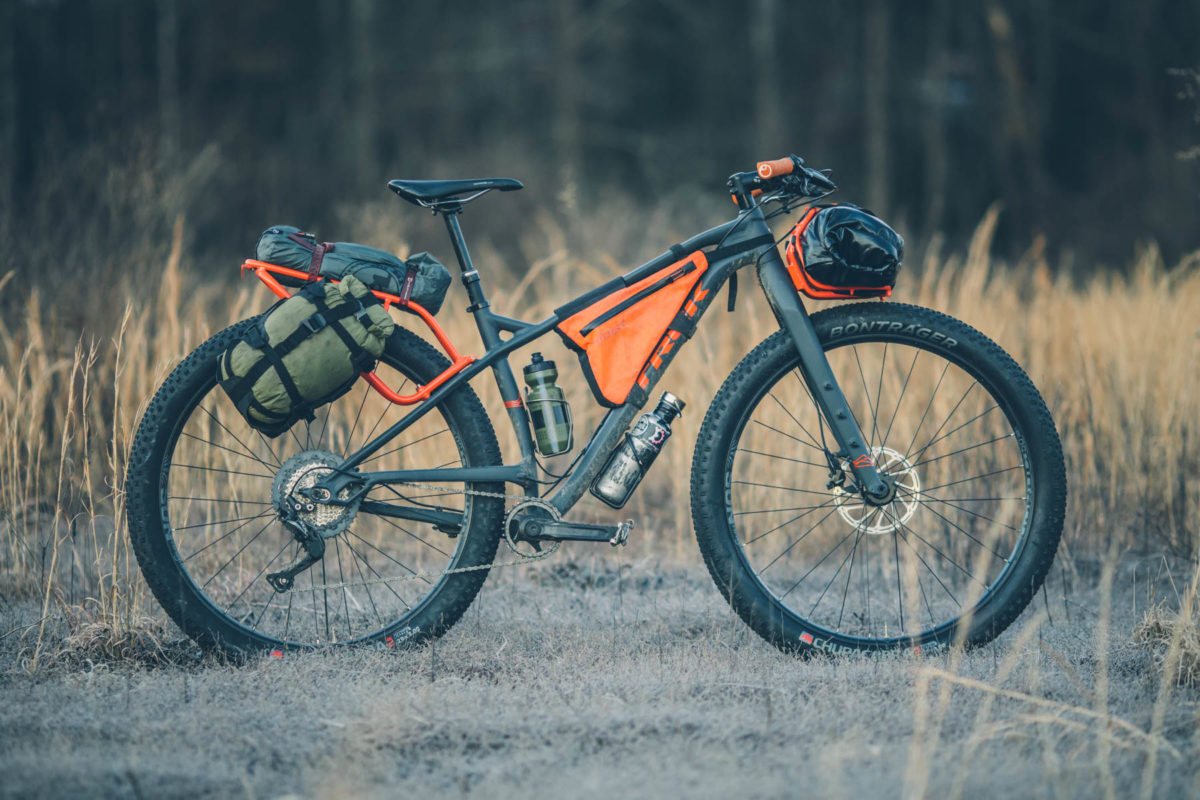
While Out Bikepacking
Although I wasn’t able to take the 1120 out on a multi-day bikepacking trip (for reasons mentioned earlier), I did set it up in various configurations and even rode it partially loaded a couple of times. The first thing that stood out to me is how tight, solid and stable the luggage systems are. The front rack is clutch. There would be little love lost if I could use it in lieu of all other handlebar harnesses or rolls from here on out. It’s nice to not worry about handlebar straps, or interference with cables and other such accessories. That said, with the proprietary mounts, this rack isn’t an option with a suspension fork, or any other fork for that matter. It’s also pretty specific to roll-style bags or cylindrical items that can’t be opened on the go.
The rear rack and harness system is also quite sturdy. It is probably one of the most movement/rattle/wag free systems I’ve used, the closest being the Porcelain Rocket Mr. Fusion. It’s clear that Trek’s engineers did their homework and focussed on creating a system that moves the weight down, while still maintaining the bike’s agility, maneuverability, and dexterity on tight and twisty singletrack.
Ryan: Since the racks are mounted much lower on the bike than a normal seat pack or front roll bag it really brings the center of gravity down and provides a more stable ride. That coupled with the dropper post means you can really lean into turns and keep up speed. These features also help to keep the bike rubber side down on steep descents. In addition, the solid rear rack eliminates any tail wag that can sometimes be experienced with standard seat bags. Generally that isn’t a big deal, but with this setup it’s removed altogether.

Trek 1120 vs Surly ECR
When I saw early photos of the 1120, I immediately wondered whether it has a similar geometry and feel to the Surly ECR, the original 29+ bikepacking beast. The answer is yes, to some extent… but it’s also quite different. Comparing the large ECR with the 19.5” 1120, the ECR is shorter in both directions. The 1120’s stack height and reach are a little bigger — 642/451mm respectively — than the ECR at 633/420. But, the Trek is also steeper overall with a seat tube angle of 73.5° and the head tube at 70.3°, whereas the ECR’s angles are 72.5 and 70°. Minor differences, but I was generally happy that the seat tube angle is steeper on the 1120. This, in effect, lengthens the 1120. So even with a 21mm shorter chainstay (425mm when the wheel is slid forward in the Stranglehold dropouts), at 112.7cm, the Trek’s overall wheelbase is still 1.6cm longer than that of the ECR. Otherwise, they have matching effective top tube lengths, and the BB drop on the 1120 is 5mm higher than the ECR’s at 80mm. This is a welcome difference, as the ECR is generally limited to 3” tires due its unusually low BB.
Honestly, I thought the 1120 felt similar to the ECR as far as its stance. However, it does seem a bit more nimble and spritely on the trail… probably owed to its lighter weight (approximately 2-3 pounds lighter, with racks) and shorter chainstay (and that was at the long setting for the dropout).
Trek 1120 vs The Stache
The Stache is Trek’s flagship 29+ hardtail. The 1120 borrows a lot from the Stache in terms of overall look and design. The most obvious similarity is the signature mid-stay chainstay layout — designed to place the drive side stay over the chain to allow a shorter chainstay length. However, the 1120 has a slightly longer chainstay than the Stache (425-440mm vs 420mm on the Stache). The Trek 1120 also gets a slightly shorter top tube, a 3mm lower BB, and a steeper 70.3° head angle (versus the 68.4° HTA on the Stache). All this is likely Trek’s recipe to account for the added gear weight, increase climbing performance, and mold the 1120 into a more ‘dirt-road touring’ friendly platform than their ultra-fast, trail-shredding Stache. In fact, according to Trek, “The 1120 is based on the old Stache [that had a slightly steeper geometry that the current 2018 model]… we chose to stay with the steeper geometry of 1st gen to recognize that this bike will generally see much lower average speeds than a typical unloaded Stache.”
The Trek 1120 as a Trail Bike
Trek bills the 1120 as a touring bike. But judging by its the dropper seat post, short chainstay, and hydro brakes, they also want it to be able to double as a trail bike. Pondering the Trek 1120 as a dedicated trail bike will probably not be relevant to a lot of folks. If you can’t imagine slinging a rigid bike around on your favorite trails, then that’s that. However, a lot of people are looking for one bike to do it all, and the 1120 will likely be tasked as such. I could even envision some folks swapping the fork for a suspension fork until a big bikepacking trip is in order.
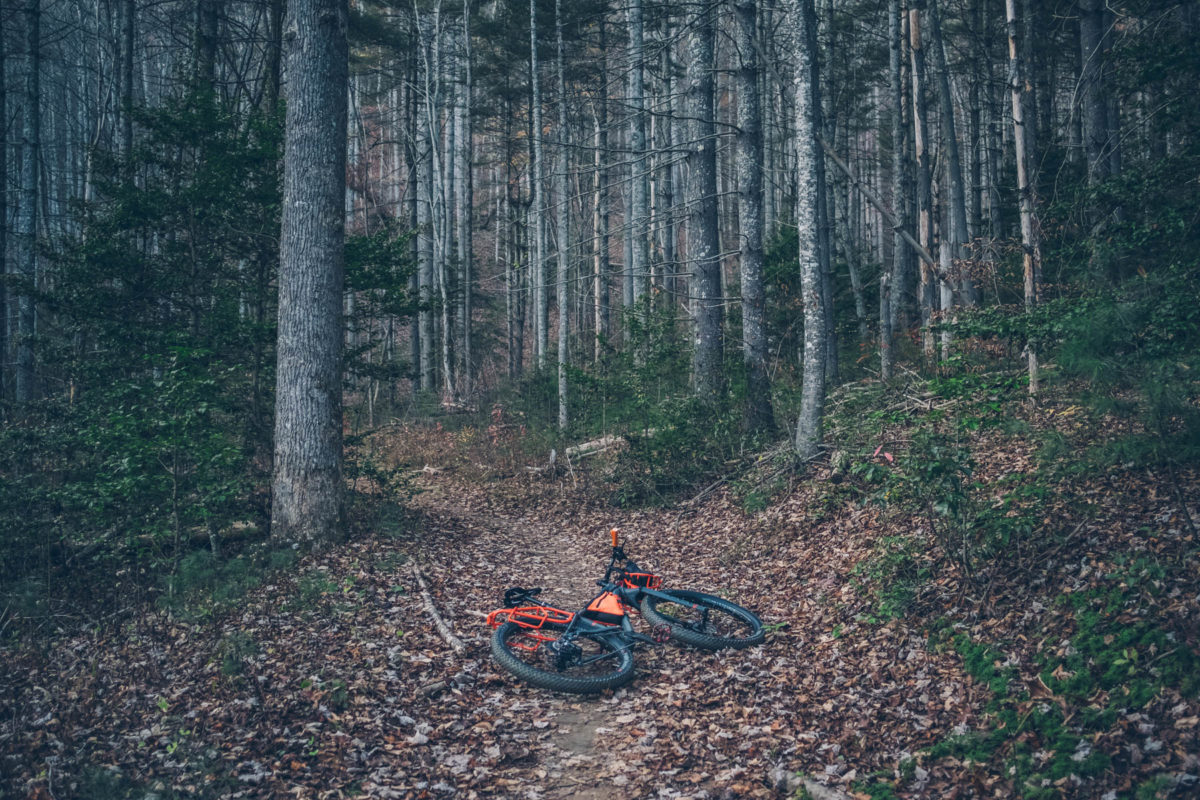
When considering 1120 as a quiver killer, the main thing that it has going for it is its relatively steep seat tube, low BB, big cushy tires, and of course, the short chainstay. As mentioned, at 425mm it’s only a hair longer than that of the Stache. However, the relatively steep head tube doesn’t exactly match. I personally would have preferred it a little slacker than 70°. That said, even with the Stranglehold dropout in the back position, the bike felt surprisingly stable during the few occasions I took it rack-free down local descents, such as the Black Mountain Trail and Ridgeline. The 1120 felt generally comfortable and capable for a rigid bike, which usually means slowing things down anyways. I don’t think this is a do-it-all bike for mountain bikers who have a discerning palate when it comes to trail geometry, but it’s certainly capable. It’s also worth noting that if you were planning on swapping a suspension fork when not in bikepacking mode, you could theoretically employ a Cane Creek Angleset to make that HTA a little slacker.
As far as the frame material, the Trek 1120 frame is welded from Trek’s own Alpha Platinum Aluminum. As Skyler found with the Kona Big Honzo, it’s hard to pinpoint the difference between aluminum and steel when there are 3” tires separating the frame from the bumps. The bike is stiff. And it’s also very light. The combination of these two traits makes it feel pretty responsive for a 29+ bike.
One thing I’ve always hated about aluminum is that ‘tink’ sound that randomly happens when a seatpost or something else is loose. Steel is far more dull and less obtrusive, and carbon just sounds like something is creaking. Aluminum can kind of be unnerving, IMO. I noticed the tink a couple of times on the 1120. Not sure exactly where it was coming from, but it went away after a while. With aluminum, it always helps to keep bolts and fittings greased and tight.
Ryan: As a newcomer to the plus tire world, I was amazed at how the tires absorb much of the small trail chatter. Cruising over small roots and rocks was a breeze and as long as I kept up momentum, the bike felt as if it would roll over most anything.
The more upright position, rigid fork and backswept handlebars are certainly features that lean more towards an off-road adventure bike than a trail slaying ninja like it’s bigger brother, the Stache. The bike does have a more nimble feel than I expected and handled a smorgasbord of terrain with a fair amount of ease.
The 20mm longer chainstays [while in the back position as we kept it] and the almost 2 degree steepened head tube angle in comparison to the Stache give the bike a much more stable feel, one that also provides more comfort on longer days in the saddle.
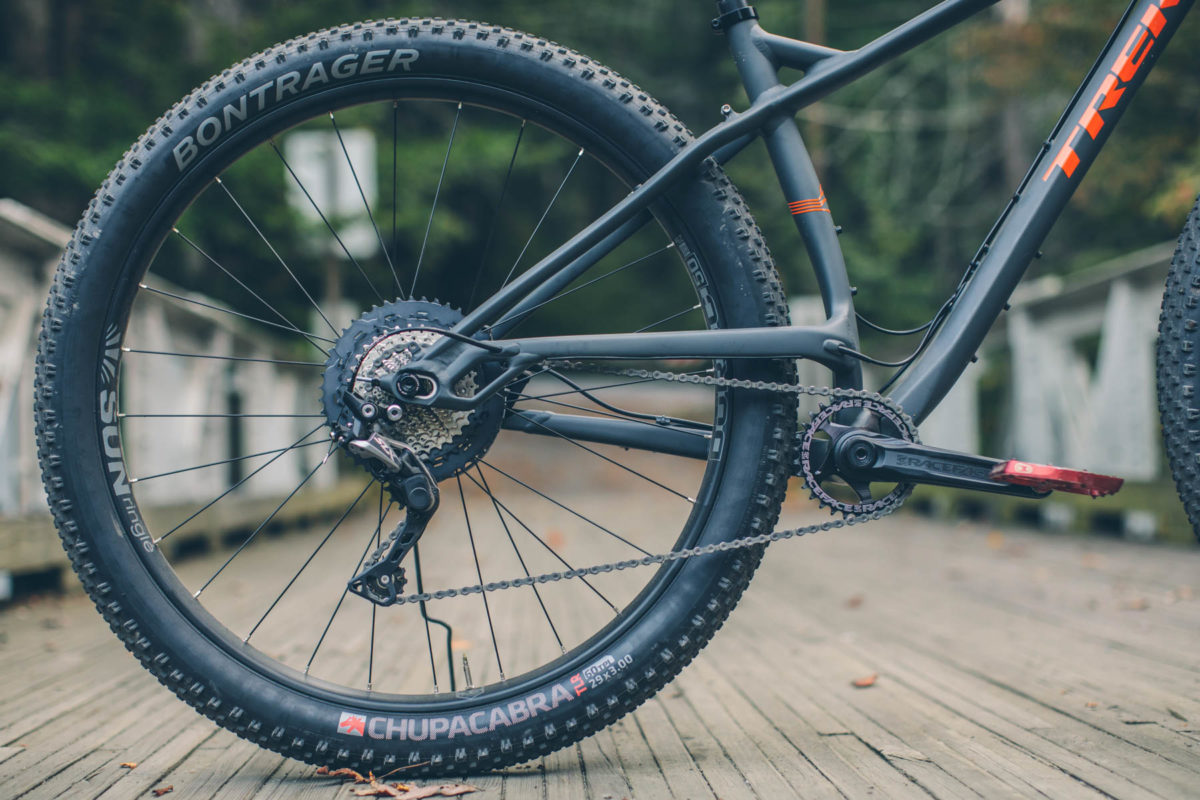
Build Kit
A few other frame highlights include a tapered head tube, internal derailleur and dropper post routing, and Trek’s own Stranglehold dropouts which allows the chain stay length to be fine tuned from 525-540mm. According to Trek, this also means that you could run a compatible 12 x 142 Rohloff hub.
The Trek 1120’s build, as expected, has a selection of Bontranger components. However, Trek made some nice choices in the bike’s bombproof drivetrain featuring mostly Shimano SLX components with a wide-range 11-46 11spd cassette paired with a RaceFace 30t chainring. This provides a granny gear with about 19.9 gear inches for loaded travel even with the voluminous 29×3″ Chupacabra tires.
There were a couple components I didn’t like. First off the Bontrager Crivitz handlebars… Unlike a lot of folks, I am just not a comfort/sweep bar convert. Even if I were, at 690mm, these bars aren’t wide enough. I am also not sold on the Sun Ringle Rims/Chupacabra combo. Both are fine while riding. While they came set up tubeless, I broke the seal when testing the new Wolf Tooth tire lever tool. It was not easy to reset the bead, to say the least. That leads me to think the tolerance isn’t quite tight enough on the rim, or the Chupa is off. If anyone has any thoughts on this, please leave a comment.
The spec also might be a little confusing to some. On one hand, with an innovative rack system, sweep bars, distance-oriented geometry, and loads of mounts, this bike is without a doubt a dirt-road touring machine that on the outset screams for big adventure in far off places. However, I would argue that the out of the box components don’t speak the same language. The dropper post, 28-spoke wheels, PF bottom bracket, and hydraulic brakes are odd choices for such endeavors. The latter is not much of a concern these days (especially for weeks or month long trips), and the other two can be remedied (if the PF BB is a concern, check out Wheels’ threaded options). On the flipside, with a short chainstay, hydro brakes, and a dropper post, the 1120 has several ingredients that make it look like a trail bike. But, the steep head tube angle and comfort handlebars don’t quite seal the deal. Nevertheless, despite the 70° headtube, I was pleasantly surprised how well the 1120 did when unloaded on the trail. So in essence, in some ways, the parts match the bike, and in others they don’t.
Here is the full build list.
Wheels
- Front Hub Bontrager sealed bearing, alloy axle, Boost110
- Rear Hub Bontrager alloy, Boost148
- Rims SUNringle Duroc 50 SL 28-hole
- Tires Bontrager Chupacabra, Tubeless Ready, Inner Strength sidewalls, aramid bead, 29×3.00″
Drivetrain
- Shifters Shimano SLX M7000, 11 speed
- Rear derailleur Shimano SLX M7000, Shadow Plus
- Crank Race Face Aeffect, 30T Direct Mount Narrow Wide
- Bottom bracket PF92
- Cassette Shimano SLX M7000, 11-46, 11 speed
- Chain Shimano HG-601
Components
- Saddle Bontrager Montrose Comp
- Seatpost Bontrager Drop Line 125, internal routing, 31.6mm (15.5: Drop Line 100)
- Handlebar Bontrager Crivitz, 31.8mm
- Grips Bontrager Race Lite, lock-on
- Stem Bontrager Elite, 31.8mm, 7 degree, w/computer & light mounts
- Headset Integrated, cartridge bearing, sealed, 1-1/8” top, 1.5” bottom
- Brakes SRAM Level T hydraulic disc
Pros
- The front rack and fork are unparallelled and offer several major advantages over typical handlebar mounted bags. Plus the fork is quite nice with two sets of triple bosses.
- With racks, this size large Trek 1120 — set up tubeless — weighs 29.4lbs… incredible for a big-footed bike with two chunky, well built racks.
- A well conceived geometry leaning more toward distance dirt tourer.
- Good choice of drivetrain components for bikepacking and dirt touring.
- Rear rack and harness system are a nice way to add a little more volume compared to a typical seat pack… all while slightly lowering the center of gravity. And it’s rock solid.
Cons
- The PressFit bottom bracket will likely be one of the biggest gripes about this bike. But, as mentioned in the Norco Search XR review, there are ways around this being a risky (or squeaky) affair.
- Playing the devil’s advocate, the aluminum frame will likely be the second con. While it’s not as vibration dampening and repairable as steel, it’s certainly lightweight.
- The frame triangle doesn’t quite jive with size large universal fit frame bags. The best bet is a custom bag if you want a frame pack.
- I would prefer a rigid seatpost and a price closer to $2k. But, considering you get two racks, the harnesses, and don’t necessarily need any bikepacking bags, it’s actually not a bad deal.
- If it were up to me, the front-end would be a little slacker.
- Size Tested Large (19.5″)
- Weight (as tested with tacks) 29.41lbs (13.34kg)
- Rider Height/Weight 6’0″/170lbs (1.83m/77kg)
- Place of Manufacture Taiwan
- Price $2499.00
- Manufacturer’s Details Trek
Wrap Up
Ryan: The Trek 1120 is a great bike for off-road excursions and anywhere you could use a little extra float, think sandy desert arroyos or loose trails. It’s comfortable, stable and provides a solid platform for strapping gear and a low center of gravity to keep you in control. I’m not sure this is the do-all bike that Trek states on the website, however it does provide a very stable off road touring option that can take you off the beaten path without having to invest in a plethora of specific bikepacking bags.
As Ryan mentioned, I’m not sold on the idea that this is a perfect do-all bike. Although Trek doesn’t necessarily claim it as such, they certainly based the build kit and spec around the idea that it’s both a dirt-road expedition bike and a modern trail bike. But, I’m afraid this approach makes the 1120 fall short at the extreme definition of each. That being said, with a few minor tweaks the 1120 can be adjusted to serve either purpose.
Ultimately, Trek’s rack systems are very smart and well executed. This is what will sell this bike. The front rack and fork is spot on. And as some riders can’t quite get their pack list down to the standard kit, or others need bigger kits or space for more water, or smaller riders need an alternative packing option, the 1120’s harness system and rear rack provides a very innovative, functional and solid solution.
When I started testing this bike the first thing that came to mind was The Baja Divide… or other such long-distance, sandy, water-starved bikepacking routes. For such trips 29+ tires are the perfect choice. And having all the gear you need on the two racks frees up five bottle mounts for water storage. The Trek 1120 begs for such pursuits. Out of the four bikes I currently have at my disposal, if I were to head out on the Baja Divide tomorrow, I’d happily swap the handlebars, saddle and seatpost, and set out with the 1120.
Please keep the conversation civil, constructive, and inclusive, or your comment will be removed.






